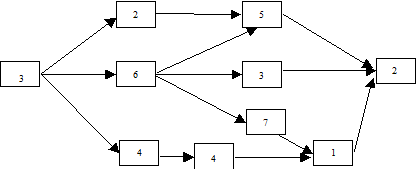
第1题:
A non-critical path activity is completed in half the time. Then,
A.The critical path is also reduced.
B.The slack in the path containing this activity will increase.
C.The total cost for this activity has decreased.
D.Manpower from this activity can be assigned to other activities.
E.All of the above.
第2题:
Activities with zero time duration are referred to as:
A.Critical path activites.
B.Noncritical path activities.
C.Slack time activities.
D.Dummies
E.None of above.
第3题:
Which of the following impacts the critical path?
A.Changing the task duration.
B.Reduce the free float of an activity.
C.Executing a backward pass
D.A or B
E.None of the above.
第4题:
153 The range of time allowed for an activity to be completed in is the _____.
A. Planned time (Duration).
B. Float time (LS - ES, or LF - EF).
C. Critical time (when ES = LS, or EF = LF).
D. Scheduled time (LF - ES).
E. Event
第5题:
The schedule risk is the _____ .
A the accumulated "expected' durations which maintain project completion.
B Critical Path adjusted by "high-risk" activity float.
C highest risk path that maintains quality.
D Critical Path when calculated with "most likely" duration.
E highest risk path that contributes the most risk toward the project completion.
第6题:
Once the logic of a network is laid out, the project manager will conduct a forward pass and backward pass through the network. This will provide information on the _____ and identification of the _____ .
A.Slack for each activity, critical path.
B.Slack for each activity, high risk activities.
C.Manpower shortages, high risk activities.
D.High risk activities, non-critical paths.
E.Manpower availability, contingency plans.
第7题:
Using the data shown in the Special window, Activities P, Q, and T are critical path activities. In order to shorten the time duration of the project, which activity should be "crashed" first?
A . P
B . Q
C . R
D . S
E . T
第8题:
The range of time allowed for an activity to be completed in is the _____.
A.Planned time (Duration).
B.Float time (LS - ES, or LF - EF).
C.Critical time (when ES = LS, or EF = LF).
D.Scheduled time (LF - ES).
E.Event.
第9题:
112 The schedule risk is the _____ .
A. the accumulated "expected' durations which maintain project completion.
B. Critical Path adjusted by "high-risk" activity float.
C. highest risk path that maintains quality.
D. Critical Path when calculated with "most likely" duration.
E. highest risk path that contributes the most risk toward the project completion
第10题:
A.activity duration estimating, schedule developing, activity resource estimating
B.activity resource estimating, activity duration estimating, schedule development
C.schedule developing, activity resource estimating, activity duration estimating
D.activity resource estimating, schedule developing, activity duration estimating